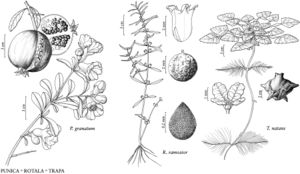Stems slender, young growth and flowering parts velutinous. Leaves of floating rosettes bearing successively longer petioles toward outer edges of rosette, to 20 cm; blade 20–40 × 25–60 mm, width greater than length, surfaces velutinous abaxially, glabrous adaxially. Floral-tube 2 mm; sepals 4–7 mm, keeled; petals obovate, 8–15 mm. Drupes 20–25 mm diam., excluding spines; horns 2–4, to ca. 10 mm. 2n = 48 (Poland, Japan), 96 (Japan).
Phenology: Flowering summer–fall.
Habitat: Relatively neutral, nutrient-rich, flowing or still waters, rivers, ponds, lakes.
Elevation: 0–400 m.
Distribution
Introduced; Que., Conn., Del., D.C., Maine, Md., Mass., N.H., N.J., N.Y., Pa., R.I., Vt., Va., Europe, Asia, Africa
Discussion
Trapa natans was first noted in Massachusetts in 1859 from an unknown origin and was recorded from the Charles River, Cambridge, in 1879. The hard, spiny fruits can cause severe puncture wounds and are slow to decay in lake and river bottoms. The species propagates by seed and by detached floating rosettes to form extensive floating mats that reduce oxygen, restrict light, crowd out native plants, and make navigation difficult. Populations grow rapidly and are difficult to eradicate except by sustained efforts over multiple seasons. Federal regulations now prohibit interstate sale and transport of T. natans. The species is considered rare and threatened in Europe.
Selected References
None.
Lower Taxa
"elongating" is not a number."timesfloral-tubelength" is not declared as a valid unit of measurement for this property.
